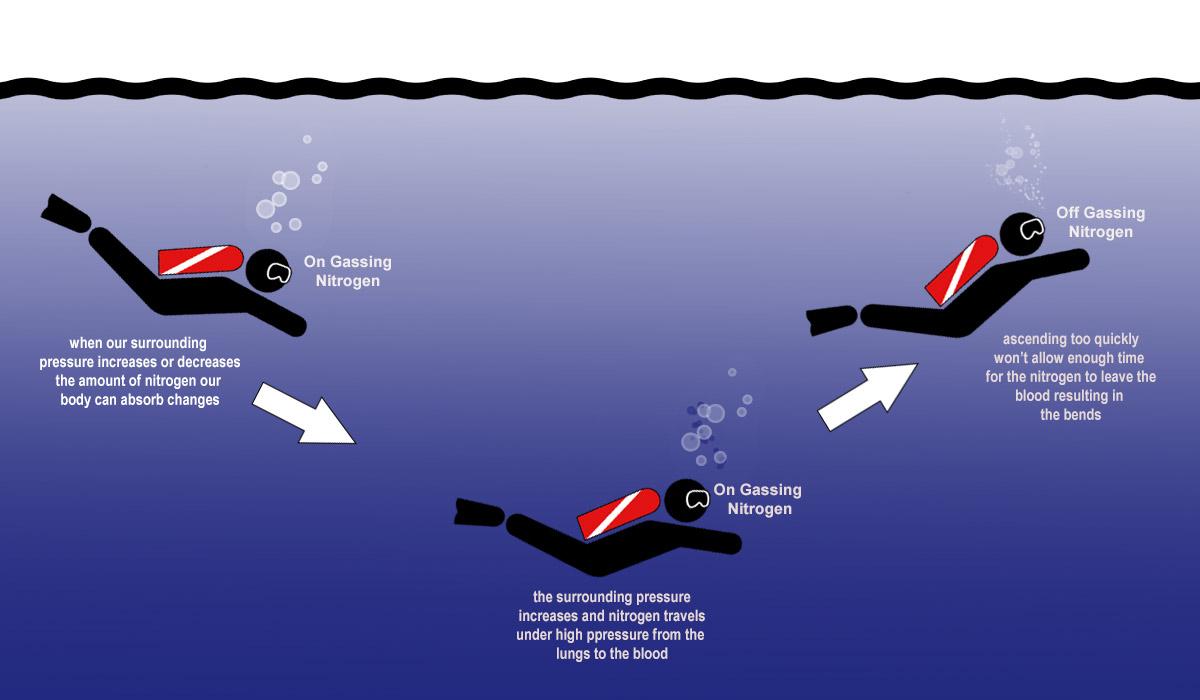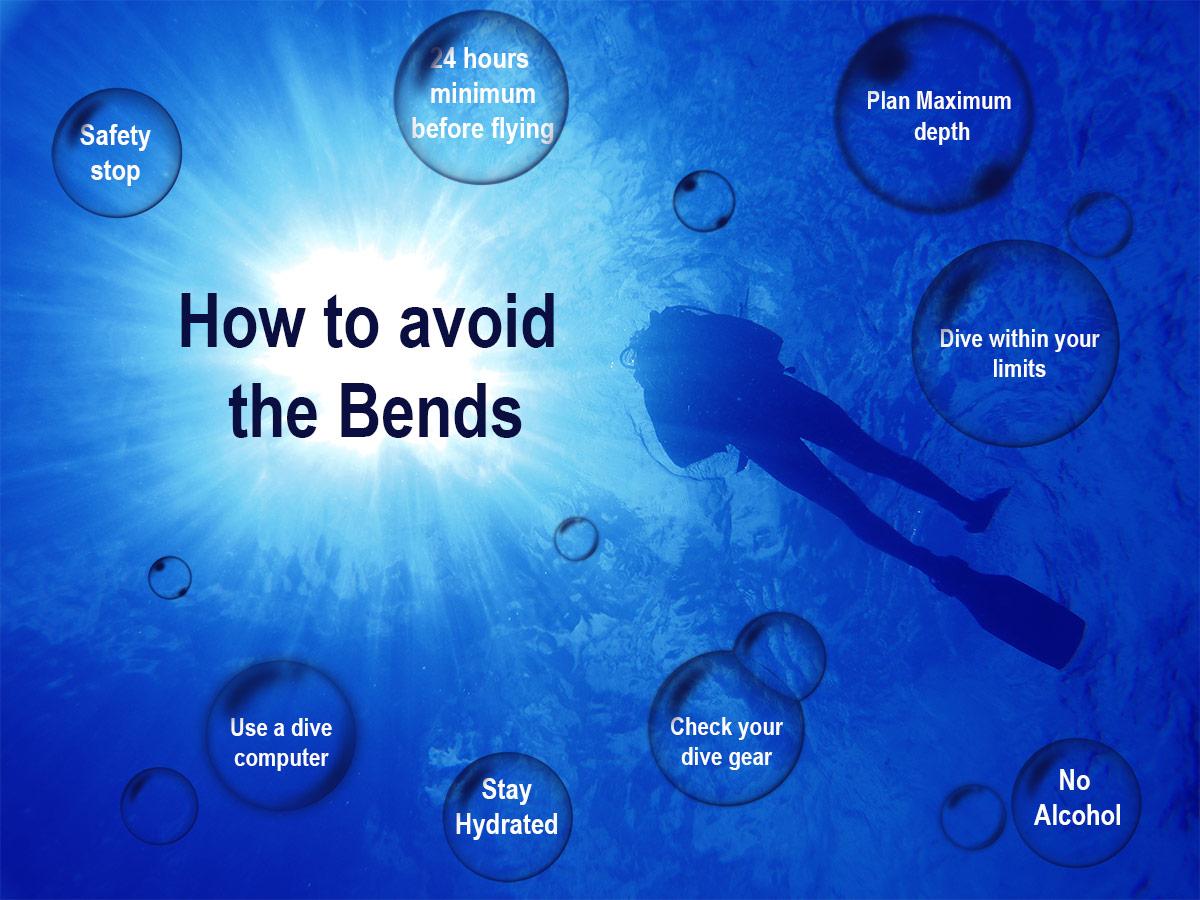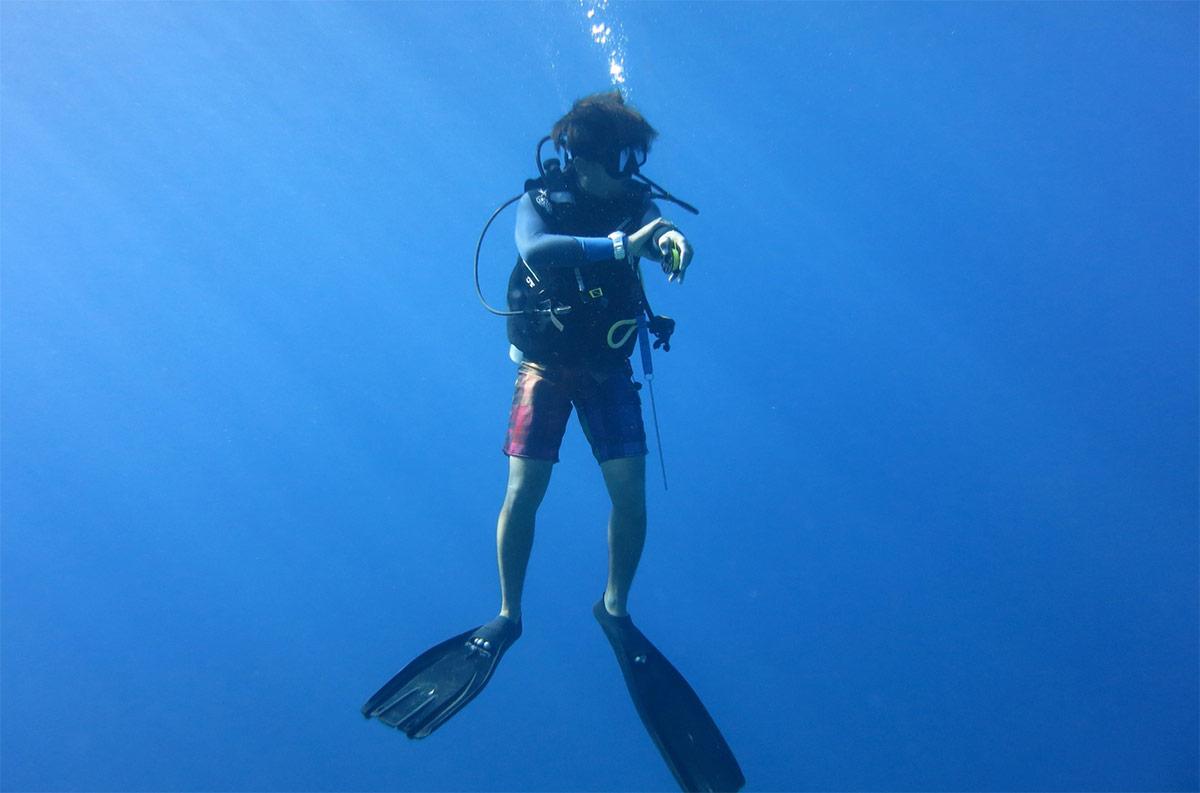This article is a brief explanation of DCS (The Bends) which is a serious injury caused by not following properly-planned dives regarding maximum depth, the length of time spent at depth, and rate of ascent. It is not a detailed or scientific text, but just enough information for new divers to understand why we plan each dive and why most experienced scuba divers wear expensive dive computer watches. When we learn to scuba dive, there are so many new things, facts and unnatural activities to learn and think about, that the science & theory of DCS is often not understood properly.
The Bends/DCS in very simple terms
Because breathing from a tank of compressed air is not natural and nor is breathing while underwater, there are scientific facts & reasons which mean we need to understand the dangers, and act accordingly. You do not need to understand much science to understand DCS how to avoid getting it.
Anyone who dives deeper than 10 metres (30ft.) while breathing air from a scuba tank is affecting the balance of gases inside the tissues of their body. The deeper you dive, the greater the effect. And the longer you stay at depth adds even more to this effect. And to make things worse, the deeper you go and/or the longer you stay deep, the slower you have to ascend to the shallows.
The cause of DCS is a build-up of too much nitrogen in body tissue that did not get the opportunity to leave the body. Normally, nitrogen can leave the body from exhaling, but this needs time and the correct atmospheric pressure. The symptoms of DCS are most-commonly pains in the joints. The most extreme cases can lead to paralysis and even death. The treatment is multi-hour sessions inside a hyperbaric recompression chamber. This needs to be started as soon as possible after symptoms are diagnosed. Don’t worry though, because all dives can easily be planned to be 100% safe.

How can divers avoid the Bends/DCS?
Before every dive, the Divemaster guide will plan how deep the maximum depth will be, plus a maximum time to stay at any particular depth deeper than 10 metres. He or she will use information about any dives by anyone in the group within the past 24 hours. In addition the Divemaster will know about the dive site, and potential sea conditions, such as current & visibility. Finally, he or she will have a Plan B in case things need to be changed during the dive due to conditions or anyone’s air consumption.
Before dive computer watches were invented, the US Navy created a set of tables for divers to use for safety. Nowadays, the dive computers calculate everything more accurately. In addition, the computers are conservatively safe, meaning that a diver can go to the limits of the computer but in reality are diving more safely than they think they are.
The display of a dive computer tells the diver lots of information, but the most-important and easiest to read is the length of time that the diver can remain at the current depth. If the diver doesn’t notice this or ignores it, then the dive computer will usually sound an audible alarm to alert the diver. Also, if the diver ascends too quickly, the computer will sound an alarm. Finally, whenever the diver reaches a depth of 6 metres after being deeper than 10 metres the dive computer will prompt a ‘safety stop’ by changing its displayed information.

What’s a safety stop, and what happens if I forget it or can’t do it for any reason?
The ‘safety stop’ is when a diver stops at a depth of 5 metres at the end of the dive, and usually stays at that depth for 3 minutes. The function of the safety stop is to give the body time to release any excess nitrogen before the diver comes out of the water. 5 metres is a perfectly-safe depth for the diver to offload the nitrogen (simply by breathing), and not add more to his or her bloodstream. Actually, a normal dive to no more than 30 metres, without exceeding the limits of the dive computer or planned profile does not require a safety stop. Divers can safely ascend slowly from depth to the surface without having to stop. But why not do it? Extra safety is better than taking risks. And anyway, in most cases the safety stop is done at a shallow part of the reef, not out in open water, meaning that it’s still interesting and fun.
If you’re unable to perform the safety stop for any reason, such as sea conditions or not enough air in your tank, then it’s not a problem providing that your dive was no deeper than 30 metres, and if you didn’t exceed any of the time limits at depth. Skipping your safety stop will cause your dive computer to sound alarms at you, but this is not a big deal. However, it’s vital that your dive was safely within the pre-planned limits and that you ascend slowly to the surface, no faster than the smallest bubbles of air you see around you is the maximum saf speed to ascend.

How to Treat Decompression Sickness
If you are diagnosed with The Bends/DCS, then there is only one treatment. The only treatment is to spend time in a hyperbaric recompression chamber. Medication, surgery, or hoping it will go away are no cure at all. Hyperbaric chambers are not standard equipment in most hospitals, and they are incredibly expensive pieces of machinery. Therefore, the treatment for DCS is also very expensive. This is the main reason that divers choose to buy scuba diving insurance, to cover the cost of emergency transport to the hospital and the sessions in the chamber.
Recompression sessions in the hyperbaric chamber involve the DCS diver sitting in a very small room, accompanied by a member of the hospital staff. During these sessions, the air pressure in the chamber is increased to simulate the diver breathing compressed air underwater. Then the pressure is carefully and very slowly reduced. Each session is usually several hours long, and the diver is likely to be breathing air rich in oxygen. The severity of each case of DCS dictates how many sessions and for how long hyperbaric treatment is required.
In summary, scuba diving is incredibly safe if done within the pre-planned limits of depth and time. There are very few cases when a diver can suffer from DCS even after diving well within the normal limits. However, these cases are extremely rare and are usually attributed to an underlying disease or condition for that particular diver. We always recommend diving insurance, which is not expensive and covers the huge costs of treatment. In all cases, be honest to yourself, to your buddy and to your DM, and stay safely within the limits that you feel comfortable with. Also, drink plenty of water and get lots of rest between dives. And if you’re able to dive on Nitrox (enriched air) it’s even better for you.


